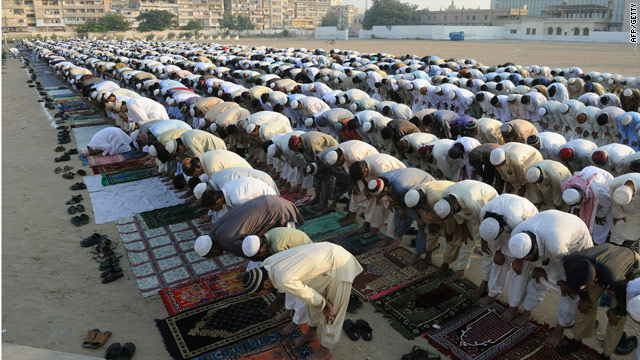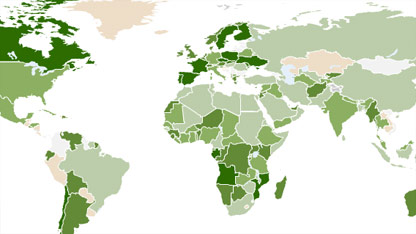Page added on January 28, 2011
Pew Research: World Muslim population doubling in 20 yrs

Twenty years ago, the world had about 1.1 billion Muslims. Twenty years from now, it will have about twice as many – and they’ll represent more than a quarter of all people on earth, according to a new study released Thursday.
That’s a rise from less than 20 percent in 1990.
Pakistan will overtake Indonesia as home of the largest number of Muslims, as its population pushes over 256 million, the Pew Forum on Religion & Public Life projects.
The number of Muslims in the United States will more than double, to 6.2 million, it anticipates.
Afghanistan’s population will nearly double, to about 50.5 million, making it home to the ninth largest Muslim population in the world.
Israel will become nearly a quarter Muslim. The Palestinian territories have one of the highest growth rates in the world.
Fractious Nigeria, where Christian-Muslim violence has left thousands dead in the past decade, will become a Muslim-majority country by 2030, the Pew Forum projects.
And two western European countries – France and Belgium – will become more than 10 percent Muslim. Sweden will hover just below that level, at 9.9 percent.
Iran, on the other hand, will see very slow growth. Iranian women have among the fewest children of anyone in the Muslim world. They use birth control at exactly the same rate as American women, 73 percent.

Explore our interactive maps showing the growth of Muslim populations by country
The Muslim share of the global population will rise primarily because of their relatively high birth rate, the large number of Muslims of childbearing age, and an increase in life expectancy in Muslim-majority countries, according to the report, “The Future of the Global Muslim Population.”
Conversion will play relatively little part in the increase, the report anticipates. It says little data is available on conversion, but what little there is suggests Islam loses as many adherents via conversion as it gains.
Pakistan’s rapid growth – adding an estimated 70 million people in 20 years – could create “a potentially lethal cocktail,” said Ghaffar Hussain of the Quilliam Foundation, which calls itself and anti-extremism think tank and does work in Pakistan.
“Pakistan is an unstable country, there are literally hundreds of jihadist groups,” he said.
And the government is not doing much to slow population growth, unlike in nearby Bangladesh, he said.
“In Bangladesh they have tax incentives not to have large families. Pakistan doesn’t have that strategy – they’re not even talking about it,” said Hussain.
“More effort should be made to finding some solutions, especially in the border region with Afghanistan,” he advised.
Governments in Europe, meanwhile, should do more to explain the value of immigration, he argued.
Muslim growth there “is coming from the first generation having large families” and will slow down, he predicted.
But the large new Muslim populations are not always welcome, he said.
“A lot of European countries don’t tell their people we need immigration for (economic reasons),” he said, adding that government also should do more to help new immigrants assimilate.
European government need “some sort of strategy of what to do when people come. Integration has been managed very badly,” he said.
The key phrase in the Pew Forum report is “growing but slowing,” says Alan Cooperman, associate director of the think tank.
The increase in the last 20 years is greater than what we expect in the next 20 years,” he said. Muslim population growth “is a line that’s flattening out. They’re increasing, but they’re getting closer to the norm, the average.”
In other words, Muslims are coming into line with global trends toward fewer children per woman and an aging population. But, the report points out, because of the existing Muslim “youth bulge,” or unusually high percentage of young people, Muslim population growth has a certain momentum that will take decades to come into line with world averages – if it ever does.
The Pew report, more than a year in the making, is part of an ambitious attempt by the think tank to calculate the number of adherents to each of the world’s major religions. The Islam report comes first, and a Christian project is in the works.
They started with Muslims, Cooperman said, because they are “the largest group for which data was lacking, and we saw public interest in knowing more.”
Despite the rapid growth of Islam, Christianity seems set to remain the biggest religion in the world for the next 20 years. There are currently more than 2 billion Christians – 30 to 35 percent of the global population – making it very unlikely that there will be fewer than 2.2 billion Christians in 2030.
“There is nothing in these numbers to indicate that in 2030 there would be more Muslims that Christians,” Cooperman said.
In fact, both Christianity and Islam could be growing, both in absolute terms and as a percentage of the whole, he pointed out.
“We don’t want people to jump to the conclusion that if Islam is growing, everyone else is shrinking,” he said. “Christianity and Islam could both be growing at the expense of other religions.”
Sub-Saharan Africa is a case in point, he said.
“Tremendous numbers are being added in sub-Saharan Africa, but… Christianity and Islam are both growing rapidly. There is not a change in the overall proportions of Muslims to Christians.”
He’s aware that the report has policy implication, but insists that the purpose of the Pew Forum is simply to provide unbiased data.
“It’s not our role to say what should be done,” Cooperman said.
What they’re aiming to do, one of the project’s leader said, is to make sure there’s reliable information available.
“There has been a lot of speculation about the growth of the Muslim population around the world, and many of those who speculate don’t have good data,” said Brian Grim, a senior researcher at the Pew Forum.
For example, the report undermines the notion that Europe is heading toward having any country with a Muslim majority. The continent will be about 8 percent Muslim in 2030, it projects.
“The data that we have isn’t pointing in the direction of ‘Eurabia’ at all,” Grim said.
“The Muslim population is growing and slowing. Instead of a runaway train, it’s trending with the general global population,” he said.
Cooperman hopes that information will help make for more intelligent discussions, he said: “In the midst of heated debate and speculation, we think that solid, reliable, empirical estimates are valuable.”
10 Comments on "Pew Research: World Muslim population doubling in 20 yrs"


dsula on Fri, 28th Jan 2011 6:36 am
WOW. I can only hope that peak-oil- famine-business gets going and FAST. Even Mexico is adding those sh*t heads, who would have thought. Where are the Adolfs when Europe needs them?
notbob on Fri, 28th Jan 2011 8:13 am
Hitler loved Muslims ya dumb shit
Rick on Fri, 28th Jan 2011 8:17 am
I have no use for religion whatsoever.
Or CNN for that matter.
George said it best:
http://www.youtube.com/watch?v=MeSSwKffj9o
Lampert Scratch on Fri, 28th Jan 2011 10:49 am
Buy ammo.
DC on Fri, 28th Jan 2011 11:18 am
Wonderful, according this article the number of bible-thumping end-times-are near ignoramuses will nearly equal the number of radicalized un-or under-employed kill-all-the-infidels muslims. They (muslims) cant maintain order now with 1.1b of them running around, does anyone honestly think they will do any better once there are 2.2 billion of them?
SilentRunning on Fri, 28th Jan 2011 12:53 pm
Populations will not be doubling if there isn’t food to kept bellies fed. Also fresh water is needed for human life.
With peak oil upon us, the food supply is already dropping. Hence the riots already happening in the Muslim world over food prices. Fast forward 20 years, and with half as much oil, and even less fresh water far less crops are going to be grown.
Throw in resource wars and attendant diseases – and I would speculate that the Muslim population (and all other humans) may very well be less in 2 decades.
Kenz300 on Sat, 29th Jan 2011 1:08 am
Limited resources meets an expanding population…. this may get ugly…
Musical chairs for resources (food, water, and energy) will leave someone standing.
Who will be left without the food, water or energy they need to survive?
Osh University on Mon, 19th Feb 2024 12:13 pm
Elevate your expertise with Osh University’s postgraduate degree programs. As a leader in education, Osh offers a transformative learning experience, empowering individuals to excel in their chosen fields.
Tempo Garments on Mon, 19th Feb 2024 12:16 pm
Discover unparalleled comfort and style with Tempo Garments collection of t-shirts for men. Crafted with precision and passion, our range offers a perfect blend of quality and fashion. From classic basics to trendy prints, elevate your casual wardrobe with Tempo Garments signature designs.
Shalamar Hospital on Mon, 19th Feb 2024 12:19 pm
Shalamar Hospital, with the best skin specialist in Lahore , is committed to delivering top-quality dermatological care, prioritizing your skin’s health and well-being.